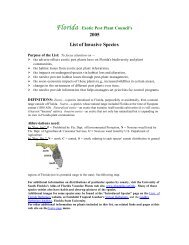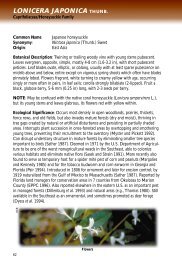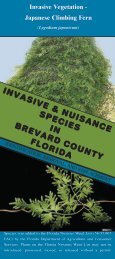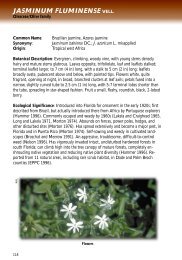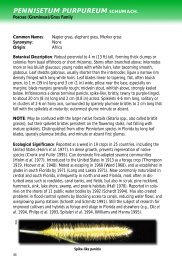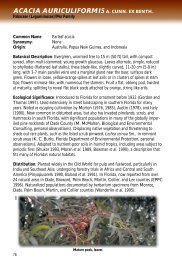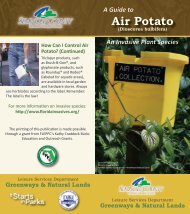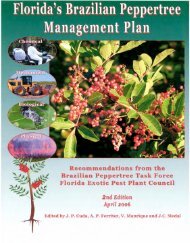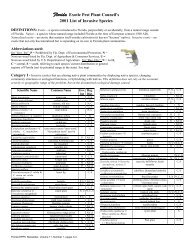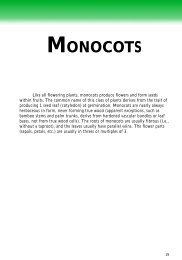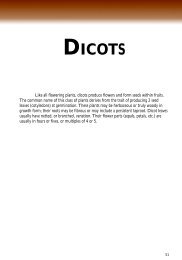Cestrum diurnum L.
Cestrum diurnum L.
Cestrum diurnum L.
You also want an ePaper? Increase the reach of your titles
YUMPU automatically turns print PDFs into web optimized ePapers that Google loves.
<strong>Cestrum</strong> <strong>diurnum</strong> L.<br />
Solanaceae/Nightshade Family<br />
Common Name: Day jessamine<br />
Synonymy: <strong>Cestrum</strong> <strong>diurnum</strong> var. venenatum (Mill.) O. E. Schultz<br />
Origin: Tropical America<br />
Botanical Description: Evergreen shrub to 2 m (6.5 ft) tall, with multiple trunks, often<br />
densely branched and branches arching. Leaves alternate, simple, short petioled (to 1.2<br />
cm, or 0.5 in); blades smooth, leathery, entire, shiny green, oval to oblong, 5-11 cm (2-4<br />
in) long, 2-4.5 cm (0.8-1.8 in) wide. Flowers fragrant in daytime, creamy white, trumpet-shaped,<br />
in several-flowered, stalked clusters at upper leaf axils; corolla tube to 1.8 cm<br />
(0.7 in) long, with tiny petal lobes curled back. Fruit an oval berry, to 7 mm (0.3 in)<br />
long, green ripening through violet to shiny blue-black, with 4-14 seeds.<br />
NOTE: May be confused with the native marlberry, Ardisia escallonioides Schlecht. &<br />
Cham., but its leaves larger, 10-15 cm (4-6 in) long, and its flower clusters terminal.<br />
Ecological Significance: Introduced to Florida before the 1930s, when Small recognized<br />
it as naturalized in hammocks and disturbed areas of the Florida Keys (Small 1933).<br />
Perhaps a natural introduction (R. D’Arcy, Missouri Botanical Garden, 1997 personal<br />
communication), but long cultivated for its fragrant flowers (e.g., Chabot 1952), widely<br />
cultivated outdoors in warm regions (Menninger 1964, Watkins and Sheehan 1975), and<br />
escaped from cultivation (Long and Lakela 1971, Tomlinson 1980, Morton 1982,<br />
Wunderlin 1982, Nelson 1996). Frequently planted in the far South (Bailey and Bailey<br />
1947, Kingsbury 1964); also naturalized as an escapee from cultivation in south Texas<br />
(Small 1933, Kingsbury 1964, Correll and Johnston 1970) and Hawaii (Morton 1982).<br />
“Abounds as a weed in the wild areas of Florida and Hawaii” (Morton 1982). Abundant<br />
in hammocks and open disturbed areas; considered a “serious threat” to natural areas in<br />
south Florida (Morton 1976). Established in natural areas of Broward and Palm Beach<br />
counties by 1978 (Austin). Invades coastal strand hammocks; can form dense thickets at<br />
the margins (L. Carter, Florida Park Service, 1997 personal communication).<br />
KAL<br />
128<br />
Mature fruits
Day jessamine<br />
Distribution: Reported from 4 preserves, including Biscayne National Park, and in<br />
Dade, Broward, and Hillsborough counties (EPPC 1966). Naturalized populations<br />
documented by herbarium specimens from Hillsborough, DeSoto, Glades, Palm Beach,<br />
Broward, Dade, and Monroe counties (Wunderlin et al. 1995). Probably introduced to<br />
Florida from the West Indies. Commonly naturalized on 3 islands of the Bahamas<br />
(Correll and Correll 1982).<br />
Life History: Found most often in dry soils (Long and Lakela 1971). Can tolerate shade<br />
and dense allelopathic litter under Australian pines (J. Duquesnel, Florida Park Service,<br />
1997 personal communication). Salt tolerant (Morton 1982, Watkins and Sheehan<br />
1975) if protected from heavy salt spray and overwash of storms (Menninger 1964).<br />
Flowers and fruits year-round (Morton 1982, Wunderlin 1982). Seeds dispersed by birds<br />
(Morton 1982). Fruits poisonous to humans and other mammals, affecting the nervous<br />
system (Kingsbury 1964, Krook et al. 1975, Morton 1982).<br />
Flowers, immature fruits, leaves<br />
129



